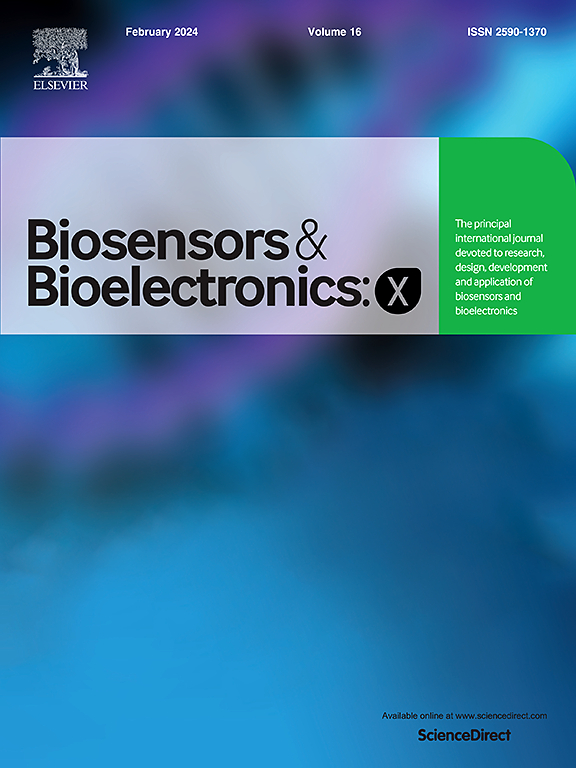基于干印碳纳米管薄膜的总睾酮检测电化学免疫传感器
IF 10.61
Q3 Biochemistry, Genetics and Molecular Biology
引用次数: 0
摘要
睾酮(TST)是一种对男性健康至关重要的激素,由于缺乏和过量的显著不利影响,包括生殖功能障碍、情绪改变和代谢失衡,需要精确监测。本研究报道了一种新型电化学生物传感器,用于快速、灵敏的即时(POC)检测血清样本中的总TST。该传感平台采用了一种具有成本效益的、卷对卷加工的碳纳米管(CNT)薄膜作为支架。为了制造生物识别层,使用自动液体分配系统将牛血清白蛋白-睾酮偶联物(BSA TST)均匀固定在碳纳米管薄膜中,实现高通量和可重复的传感器制造。该生物传感器采用竞争性免疫测定原理,其中样品中的TST与固定化的BSA TST竞争抗TST马萝卜过氧化物酶偶联物(AbHRP)抗体的结合位点。采用−0.2 V对Ag/AgCl墨水的电流法监测H2O2与3,3 ',5,5 ' -四甲基联苯胺(TMB)氧化还原介质的亲和反应,动态范围为82-1080 ng/dL。检测限为12.7 ng/dL,定量限为82 ng/dL。在加标人血清中的验证显示出优异的性能,可量化的结果与健康男性TST的既定生理范围(186-1180 ng/dL)非常吻合,突出了该生物传感器在临床应用中的潜力。本文章由计算机程序翻译,如有差异,请以英文原文为准。
Dry-printed carbon nanotube film based electrochemical immunosensor for total testosterone detection
Testosterone (TST), a critical hormone for male health, requires precise monitoring due to the significant adverse effects of both deficiency and excess, including reproductive dysfunction, mood alterations, and metabolic imbalances. This study reports a novel electrochemical biosensor designed for rapid and sensitive point-of-care (POC) detection of total TST in serum samples. The sensing platform utilizes a cost-effective, roll-to-roll processed carbon nanotube (CNT) film as a scaffold. To create the biorecognition layer, bovine serum albumin-testosterone conjugate (BSA TST) was uniformly immobilized into the CNT film using an automated liquid dispensing system, enabling high-throughput and reproducible sensor fabrication. The biosensor employs a competitive immunoassay principle, where TST in the sample competes with immobilized BSA TST for the binding sites of antibody against TST horse-radish peroxidase conjugate (AbHRP). Amperometry at −0.2 V vs. Ag/AgCl ink was used to monitor affinity reaction upon addition of H2O2 with 3,3′,5,5′-Tetramethylbenzidine (TMB) redox mediator yielding a dynamic range of 82–1080 ng/dL. Limit of detection (LOD) and limit of quantification (LOQ) of 12.7 and 82 ng/dL were achieved respectively. Validation in spiked human serum demonstrated excellent performance, with quantifiable results aligning well with the established physiological range of TST in healthy males (186–1180 ng/dL), highlighting the potential of this biosensor for clinical applications.
求助全文
通过发布文献求助,成功后即可免费获取论文全文。
去求助
来源期刊

Biosensors and Bioelectronics: X
Biochemistry, Genetics and Molecular Biology-Biophysics
CiteScore
4.60
自引率
0.00%
发文量
166
审稿时长
54 days
期刊介绍:
Biosensors and Bioelectronics: X, an open-access companion journal of Biosensors and Bioelectronics, boasts a 2020 Impact Factor of 10.61 (Journal Citation Reports, Clarivate Analytics 2021). Offering authors the opportunity to share their innovative work freely and globally, Biosensors and Bioelectronics: X aims to be a timely and permanent source of information. The journal publishes original research papers, review articles, communications, editorial highlights, perspectives, opinions, and commentaries at the intersection of technological advancements and high-impact applications. Manuscripts submitted to Biosensors and Bioelectronics: X are assessed based on originality and innovation in technology development or applications, aligning with the journal's goal to cater to a broad audience interested in this dynamic field.
 求助内容:
求助内容: 应助结果提醒方式:
应助结果提醒方式:


